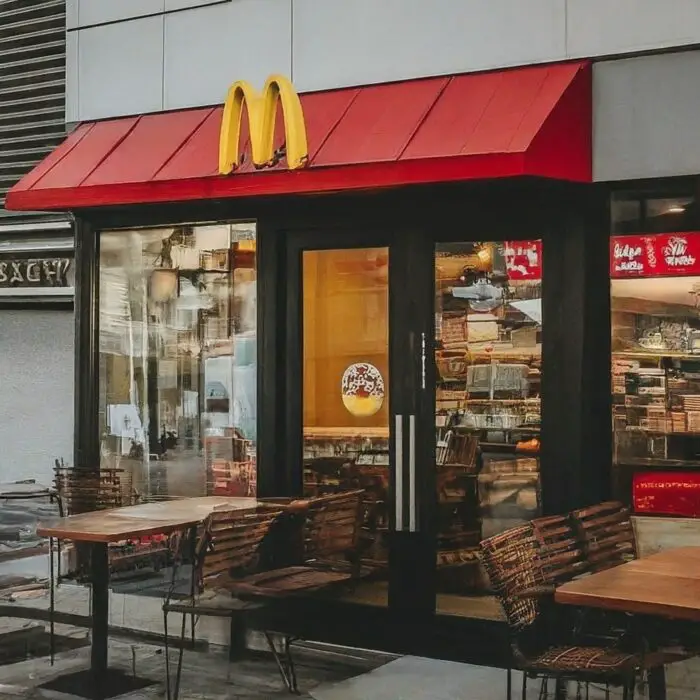
Mcdonald’s restaurant
‘McDonald’s is arguably the most iconic fast-food chain in the world. Its golden arches symbolize not only affordable and quick meals but also a cultural phenomenon that has evolved over the decades.’
McDonald’s is arguably the most iconic fast-food chain in the world. Its golden arches symbolize not only affordable and quick meals but also a cultural phenomenon that has evolved over the decades.
The brand’s menu is a testament to its ability to innovate while maintaining its classic offerings. This article delves into the transformation of McDonald’s food menu, tracing its journey from its inception to its most recent innovations.
The Birth of the Classics
When Richard and Maurice McDonald opened their first restaurant in 1940, the menu was simple and concise, featuring items like hamburgers, cheeseburgers, soft drinks, and apple pie.
The simplicity was driven by a focus on speed, they introduced the “Speedee Service System” in 1948, revolutionizing the fast-food industry.
The menu was intentionally limited to ensure quick service, but it set the foundation for McDonald’s future.
Big Mac: The Game Changer
The introduction of the Big Mac in 1967 marked a significant milestone. This item, consisting of two beef patties, special sauce, lettuce, cheese, pickles, and onions on a sesame seed bun, became an instant hit.
Developed by franchisee Jim Delligatti, it was initially introduced in the Pittsburgh area before becoming a nationwide sensation.

The big mac
The Big Mac represented more than just a new menu item; it demonstrated McDonald’s ability to create iconic products that would remain staples for decades.
Expansion and Diversification
The 1970s and 1980s were periods of rapid expansion and diversification for McDonald’s. As the company grew globally, so did its menu, adapting to different tastes and cultural preferences around the world.
Happy Meal: Targeting Families
Introduced in 1979, the Happy Meal aimed to attract a younger demographic and their families. This kid-focused meal came with a choice of hamburger or Chicken McNuggets, fries, a drink, and a toy, making meals more enticing for children.
The Happy Meal was a brilliant marketing strategy that not only boosted sales but also established brand loyalty from a young age.
Chicken McNuggets: A New Protein Source
Another significant addition was Chicken McNuggets, introduced in 1983. These bite-sized pieces of chicken quickly became a popular alternative to beef.
Their success was due in part to their convenience and the variety of dipping sauces available, which appealed to both children and adults.
Breakfast Menu: Broadening Horizons
Recognizing the untapped potential of breakfast, McDonald’s launched its breakfast menu in the early 1970s. Items like the Egg McMuffin created by Herb Peterson in 1972, became morning staples for many Americans.
The breakfast menu expanded over the years to include items like hotcakes, sausage biscuits, and breakfast burritos, catering to a range of morning cravings.
Embracing Health and Customization
As dietary trends evolved and health consciousness grew, McDonald’s adapted by introducing new menu items and options to cater to these changing tastes.
Salads and Wraps
In the early 2000s, McDonald’s expanded its menu to include healthier options like salads and wraps. These items were designed to appeal to health-conscious consumers looking for alternatives to traditional fast-food fare.
The Premium Salads line, launched in 2003, featured fresh greens, fruits, and a variety of proteins, offering a balanced meal option.
Customization and Transparency
In response to the growing demand for personalized dining experiences, McDonald’s introduced the “Create Your Taste” platform in 2014, allowing customers to customize their burgers with a variety of toppings and ingredients.
This initiative aimed to provide more control over meal choices and enhance customer satisfaction. Additionally, McDonald’s made strides toward greater transparency by providing detailed nutritional information, enabling customers to make informed decisions.
Technological Integration and Modern Innovations
As technology advanced, McDonald’s capitalized on new opportunities to enhance its menu and customer experience.
Digital Kiosks and Mobile Ordering
The introduction of digital self-order kiosks and mobile ordering apps revolutionized the ordering process.
These innovations allowed customers to browse the menu at their own pace, customize their orders, and even access exclusive deals.
This shift toward digital ordering not only improved efficiency but also created a more personalized dining experience.
Plant-Based Offerings
In response to the growing popularity of plant-based diets, McDonald’s ventured into the plant-based market.
In 2021, the company introduced the McPlant burger, developed in collaboration with Beyond Meat.
This plant-based alternative aimed to cater to the increasing number of consumers seeking sustainable and ethical food choices.
Regional Variations and Cultural Adaptations
One of McDonald’s strengths is its ability to adapt its menu to regional tastes and preferences, making it a truly global brand.
Unique Regional Items
Around the world, McDonald’s offers unique menu items that cater to local tastes. For example, in Japan, customers can enjoy the Teriyaki Burger, while in India, where beef is not widely consumed, the McAloo Tikki (a potato-based patty) is a popular choice.
These regional variations demonstrate McDonald’s commitment to meeting diverse culinary preferences.
Limited-Time Offers and Collaborations
McDonald’s frequently introduces limited-time offers and collaborations with local chefs or popular brands to keep the menu fresh and exciting.
These special items create a sense of urgency and exclusivity, encouraging customers to try something new and unique.
Looking Forward
The evolution of McDonald’s menu reflects its ability to adapt to changing tastes, dietary trends, and technological advancements.
As the brand continues to innovate and respond to consumer needs, it remains a leader in the fast-food industry.
Whether through classic favorites or modern innovations, McDonald’s has proven its commitment to providing a diverse and satisfying dining experience for customers worldwide.
